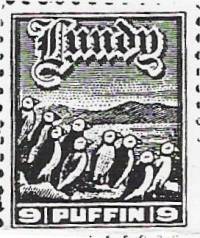
Fundy Stamp Collectors Club
P. O. Box 302
Moncton N.B.
E1C 8L4
Since 1997

 |
|
 |
Feature ArticleFrom an article by Littleton Stamp Co. Littleton, NH Date unknown |
 |
-- and the strange story of the man who thought he was King of Puffinland.
These stamps tell an extraordinary tale - about a man who set himself up as king of an island off the coast of England only a
few years ago.
The story begins in 1925, when a wealthy Englishman, Martin Harman, purchased the tiny 3-mile long island of Lundy off the coast of
Devon. Presently Mr. Harman had an idea. "Since I am owner of this island," he mused, "why shouldn't I also be king?"
The idea seemed to make sense to Mr. Harman, and like an intelligent ruler, he proceeded to coin money and issue postage stamps
for use by the islands inhabitants. The stamps and coins bore a picture of the puffin, a paunchy bird with a supercilious expression
which inhabits the island in great numbers.

At first all went well with the Lilliputian kingdom. But in 1931 the British government got wind of what was going on. By Jove! Chap coining money, don't you know. Bear looking into, and all that, eh what! The result was that "King Harman" was summoned to court and charged with unlawfully coining money. A justice of the King's Bench fixed a stern eye on the monarch of Lundy.
 |
"Who did you say is sovereign of Lundy?" Asked the judge. "I am!" stated Mr. Harman emphatically. "And as sovereign of Lundy I coined puffins and half-puffins as I have a right to do". But the court took a dim view of His Majesty King Harmanís regal pretensions. King Harman suddenly found that he was an ex-king, was fined 5 pounds, and was ordered to relinquish his royal prerogatives. |
 |
Today, Lundy is part of the British Empire, and former King Harman is an ordinary subject of King George. But the stamps remain, a fascinating item for collectors, unique in postal history. For they are the only British stamps ever issued - not by the British government, not by a British Dominion, commonwealth, colony or possession - but by a now private citizen. His exalted Ex-Royal Highness, King Harman I, Ex-Monarch of Puffinland! |
 |
Error? Freak? Forgery? Mr. David Morris, of the Fundy Stamp Collectors Club recently provided this copy of a 14p Machin stamp. NOTE the small circle below the nose, and the small diamond near the ear. If any reader has seen this before, or has a possible explanation, please provide to the Club address. He has not been able to find it in any error catalogue. |
|||
 |
After soaking, stamps should be dried face down on absorbent paper, such as paper towels. Old newsprint can be used safely in most cases. As the stamps dry, they may curl. |
| A large book makes a good weight. Stamps should be pressed in this manner for at least a few hours, or even days, if necessary.
Then the stamps can be stored away.
Tell your friends and relatives that you are a stamp collector. Ask them to save stamps from their mail. Your grandparents also may
have some old envelopes in the attic.
|
 |